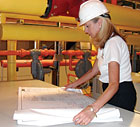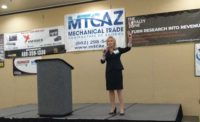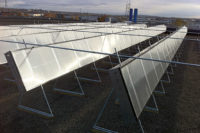
It’s agreed. Women should work in the HVACR industry. That was an easy question. So simple in fact, many of the contractorsThe NEWSposed that question to were seemingly surprised we even asked. It was the qualifying question as to where women fit in the HVACR industry that produced some differing opinions. Some felt that a woman could easily do any job in the HVACR industry that is available. Her only limitations would be her own training and capabilities. Others didn’t come right out and say it, but some of their responses limited women more to office functions, dispatch, and sales - the communications side of the business.
Overall though, the respondents seemed more than tolerant of the idea of having a competent woman, no matter which role she chose, as a part of the industry.
“This is not a gender specific industry,” pointed out Walter Mott, owner of Dean’s Shop in San Marcos, Texas. “A qualified person, regardless of sex, can fill any position.”
Being part of the HVACR industry, however, takes hard work and planning. It is a process; and with guidance, a woman can make a successful career, but her first step is to choose the HVACR industry.
CHOOSING HVACR
Female participation in the national workforce is an increasing trend. Salaries are further leveling out in comparison to their male counterparts, and an overall increased acceptance is providing new career opportunities from which woman can choose. The tricky part can be getting them to choose the HVACR industry.According to a report, “Women and the Economy: 25 Years of Progress But Challenges Remain,” produced in August of this year by the U.S. Congress Joint Economic Committee (JEC), women comprise one-half of all U.S. workers, and over one-half of all American women are currently in the labor force. The report measured 1984’s female work- force at approximately 46 million and 2009’s workforce at approximately 66 million.
“In 1984, women made up 50 percent or more of the workforce in three industries: government, education and health services, and financial activities,” said the report. “By 2009, women made up 50 percent or more of the workforce in 5 industries: government, leisure and hospitality, education and health services, financial activities, and other services.”
Other industry sectors, however, experienced little to no progress between 1984 and 2009, according to the report. Stats dropped in the information and manufacturing industries and the construction industry eked out a marginal increase. In 2009, women comprised just over 13 percent of construction employees as compared to 1984’s 12 percent.

Understanding HVACR design blueprints and schematics, Mary Marble, president of Marble Mechanical Services LLC, Birmingham, Mich., is able to make informed decisions about the company and about individual jobs.
STARTING A CAREER
Once a woman has chosen the HVACR industry, starting her HVACR career is much the same as starting any other career - choose a path. There are many paths in this industry and not all of them end at office staff or service tech. The key is to learn the different components of the industry and choose a direction that best fits the abilities and desires of the applicant.“I have seen a few female service technicians, but it has been only several that dare to take on the challenge,” said Donald Jenkins, service manager, at Shapiro and Duncan in Rockville, Md. “The HVACR industry is a prime career opportunity for females due to the known fact that women are very detail oriented and can out multi-task most men. I have known numerous women in the sales side of the business and they have done exceptionally well in residential and commercial sales and the front or back office is another huge opportunity for women to perform well.”
Ann Kahn, president of Kahn Mechanical Contractors in Dallas, has been in the HVAC business for 36 years. During that time, she has had women call on her company as suppliers and has herself hired two female technicians.
“I believe a woman is entitled to any position in our industry, whatever she desires and can handle physically and professionally,” she said. “At this point in time, at least in our part of the country, under most circumstances, women are accepted by the majority of the public.”
She went on to warn aspiring female HVACR industry members that some prejudice still remains. “No matter where you are, you will always find a few people who can’t or won’t accept this phenomenon of female acceptance in the workforce.”
Once a career path is decided on, it is imperative to gain the proper training and certifications. Whether in the medical or the HVACR field, training is a must for success, especially in the face of heightened scrutiny of formerly male dominated industries.
“The expertise and training needs to occur, as without it, women are only a pretty face and will get buried quickly by the men of the industry,” said Barbara Dolim, LEED AP, executive director of Mechanical Service Contractors of America, Rockville, Md. “The key to success is training, schooling, training, and more schooling - schooling beyond the typical union apprenticeship.”

Ann Kahn, president of Kahn Mechanical Contractors in Dallas
BUILDING A BUSINESS
Not limited to working in the business, there are some female owners of HVACR businesses in this industry as well. Kahn is one example, and so is Saundra Jones, president of Alpine Air Inc. in Jacksonville, Fla. Jones’ company has existed for eight years. She and her husband started it together and approximately six months into the project, she assumed full ownership and responsibilities. The work has been a challenge and the economy has strained her company, just as it did many others, but the doors are still open and Jones is hoping that there will be more women who choose to be HVACR owners.“Being a woman-owned and -operated business in a construction trade is tough enough, but being in the HVACR trade put me in a very, very small group,” she said. “Last I checked, the Department of Labor stated that 1.5 percent of construction companies were woman-owned and 0.5 percent of HVACR companies were woman-owned, but they don’t say how many are actually operated by women and not just owned on paper.”
One of the bigger challenges she faced early on was proving herself. “From our suppliers to our commercial customers, it has been a challenge for them to understand that I am not just the girl that answers the phone,” noted Jones. “I have gone out on problem jobs, lugged equipment to the roof, and told general contractors when to back off.”
Having proved herself, most of the doubters have moved on.
ASSOCIATION PARTICIPATION
One thing that Jones said she wouldn’t have made it without was the assistance provided by different associations. Associations can be an important part of any contractor’s business and these entities are not only welcoming to women, but they have made strides to place women not just in a place of membership but also in places of leadership.Take, for example, Angela Simon of Western Allied Mechanical in Menlo Park, Calif. She is not only a woman who has chosen the HVACR industry, but she is also a woman who is involved with the Sheet Metal and Air Conditioning Contractor’s National Association (SMACNA). In 2007, she was elected to SMACNA’s board of directors as the first-ever woman to serve on the association’s board.
Other associations continue to acknowledge female leadership in the industry as well. One in particular is Women in HVACR (WHVACR) which is currently led by Kimberly O’Neal, president.
“This organization was organized exclusively for educational purposes to further the growth of women in all areas of the HVACR industry, including technical, sales, management, and ownership,” said O’Neal, citing the association’s website. “It is our goal to provide our members with a variety of opportunities to network and develop in a professional environment.”
ANSWERS NEEDED
Not every challenge of being a woman in a primarily male industry has been lifted, but the HVACR industry continues to further open its doors to women seeking a stable, well-paying career. If you are a woman and you are interested in a career in HVACR, the opportunities are there. With the increased open-mindedness and equality, career opportunities, ownership abilities, and established support systems in place, why aren’t more women working in the HVACR industry? Quite frankly, we aren’t sure why. You tell us.Ladies, send The NEWS a 50- to 100-word description of where you are at in the HVACR industry, how you got there, and where you are headed, along with your photo, name, company, and standard contact info. We will compile the results and post it in a future feature forThe NEWS.
Gentlemen, we want to hear from you too. What do you think about women working in the HVACR industry?
FEEDBACK REQUESTED: Please send all correspondence via e-mail to Angela D. Harris at angelaharris@achrnews.com.
Sidebar: Should Women Be in HVAC?
The following are some of the responsesThe NEWSreceived to the question, “Should women work in the HVACR industry?”“Yes, women should work in HVAC. First of all, they make great customer service people. Also, they make great service technicians. All in all, there is no job that a woman can’t fill. Many can be done better by women.”
- John Sigerson, O’Connor Co. Inc.
“My daughter has installed. At a local supply house, we have a female that is in the shipping/handling department. I have also met a daughter managing a company. There are no boundaries as far as I’m concerned.”
- Paul Sammataro, Samm’s Heating and Air Conditioning
“Anyone would be hard pressed to find a position in the HVAC industry that a female could not do. While there are some physical restrictions, many of the ones that used to exist have been engineered out of the industry. Stair climbers, duct jacks, and other tools have made this area of the job less strenuous on everyone, so that we reduce the physical strain on all of our employees.”
- Eric Knaak, Isaac Heating & Air Conditioning
“Women can serve in every category of job from the president of a company; i.e., Carol Pointdexter, president of Baker Distributing, to owners, techs, or front desk personnel.”
- Kathy Corr, North American Technician Excellence
“Some of my toughest competition comes from well run women-owned businesses. I welcome skilled, knowledgeable competition, and I would encourage women who are curious about the HVAC industry to consider any aspect of the business that interests them.”
- Jim Hussey, Marina Mechanical
“There is no reason that women (in general) cannot do this kind of work. In fact I have worked with some women who are better than some men in the industry. The qualities that are desired in a technician can be found in both men and women. It also true that the undesirable traits are also found in both men and women. If you hire based on desirable traits vs. undesirable ones, and not on gender, you will end up with a much better workforce.”
- Ratib Baker, RSES Chesapeake Chapter
“I firmly believe that a woman can do anything that she sets her mind to do, whether it is in HVAC, engineering, teaching or brain surgery. It is an unfortunate fact, however, with some career choices that have traditionally been male dominated, a woman seems to have to prove herself much more than a man.”
- David Williams, Gateway Supply
“Women most certainly should work in the HVAC industry. I can’t think of a job or skill in our field that a woman could not perform. As a matter of fact, with the approaching crises that our industry faces with the shortage of young trainable mechanics, women present an opportunity. Our industry is probably a real good opportunity for women since, once trained, she has the opportunity to work independently, advance based on her own abilities and receive a very substantial income.”
- James Herndon, Controlled Conditioned Corp.
“There is nothing a woman can’t do, including my job.”
- Dick Starr, LEED AP, The Enterprise Corp.
Publication date:10/11/2010






